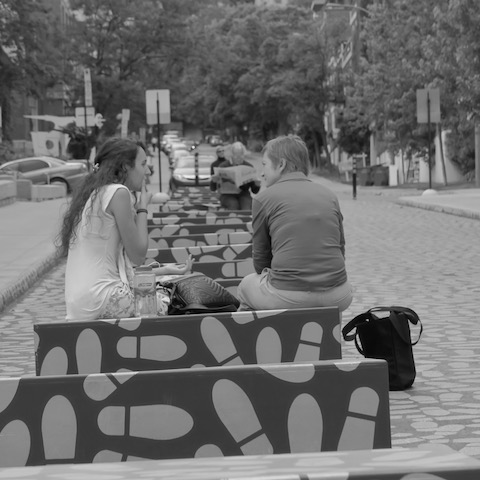Once a year around end of June, the city turns into a scavenger paradise as some residential sidewalks are stacked with unwanted furnishings left by moving tenants. When, on one particular street of my neighbourhood with a upgraded and planted median strip, the tenants went overboard creating quite an unsightly scene by dumping furnishing and garbage on that strip, the city reacted by posting large billboards treating that behavior as being pigstie-like (“cochonneries” in French) and threatening hefty fines to those who do not observe scheduled city pick up days (see feature image).
Hardly a topic for an “Encounter points” example, if it were not for the fact that the billboards are still up and not vandalized by the locals, indicating sympathy for the city’s reaction. Something like collective pride of the neighborhood had been shamed and was now being vindicated by threatening the offenders of consequences of their pig-like behavior … publicly.
This situation reminds me of Mary Douglas’ insightful “Dirt is matter out of place” i.e. the discarded furniture was considered pigsty behavior if “dumped” in the wrong place (the median strip), but would be acceptable if “stacked” in the correct one and at the proper time (the sidewalk on pickup days).
This insight revealed to me not only the situation’s culturally determined behavioral expectations, but also the possibility of finding examples that could qualify as encounter points experiences … i.e. creatively mixing negative and positive connotations.
Where and when therefore could these two orders of urban realities conceivably meet, and participate to a “fulfilling city life”?
The case of the Museum sponsored street installation.
Assigned to the Museum of fine arts and its outdoor exhibition of sculptures, this pedestrian segment of street is given to artists, on a rotating basis, to come up with original installations that would complement the sculptures without hampering the access of emergency vehicles.
In this case, the wall to wall covering of the street with stenciled shoe soles was accompanied by a row of benches that is explicitly aligned with the row of parked cars seen in the rear.
The irony of two men seated as if in a driver seat and the unself conscious attitude of the two women seated as if on a park bench could have easily made of them the subject of sculptures, if it were not for the fact the artist aimed at a live interactive use of the rows of seats in keeping with the critical questioning of accepted use patterns of the public realm … as central to an encounter point experience.
The case of the impromptu bike stand made of stacked pavers.
This stack of pavers was set up while working on underground utilities running below the paved area in front a subway station. The opening in the stack is what caught my eye as it required some basic understanding of cantilever counter weighing to span over it with paving units.
Its sculptural aspect seems to have made it noticeable, and respected, since it is still standing in the middle of pedestrian traffic, and is curiously used here as a temporary bike stand.
Together with the graffitied postal transfer box it makes for an odd urban furnishing couple, almost given credence by the fact that the bike owner did not take the trouble to lock the bike wheels, depending on an impression of “formal untouchability” to “cover” his bike.
A complete reversal of the usual reading of stacked material left in the public domain as usually available for the take unless well delimited…or in this case, well formed and grouped.
Another instance of what I have termed ”urbane know how” working through a quiet unassuming encounter point experience.
The case of the side yard clothesline
When I sent this image to my friend the cultural geographer F. Forshaw, he answered back:
“Love the clothesline, so familiar from early days in England. Glad life’s cozy there.”
Familiarity and coziness ten yards away from a busy one way boulevard, counting on the hedge to separate private and public domains?
Does the EL NORTE sequence of “urbane” mechanical clothes drying demonstration, versus the “familiarity” of outdoor bedsheets spreading, not come to mind?
If I say that the clothesline belongs to the occupants of the half basement unit (the doorway to it is visible behind the hanging green tee shirts), and that they are of Asian cultural stock?
If I further add that the lawn is the side yard of the property that occupies a corner lot and that the back yard serves the ground floor unit via an elevated reeled loop clothesline, and that the front yard is ceremoniously landscaped as it should be?
If I finally add that this side yard also serves for taking the sun with coffee and company?
Then, how does that measure for “coziness” as possible encounter point criterion for a fulfilling city life?
All photos credit Maurice Amiel
[alert type=alert-white ]Please consider making a tax-deductible donation now so we can keep publishing strong creative voices.[/alert]
Maurice Amiel, M. Arch. (U.C. Berkeley) is retired professor of Environmental Design at the School of Design, University of Quebec at Montreal, where he was involved mainly in environment-behaviour teaching and applied research projects. In order to promote environmental awareness, he has turned after retiring to documenting and writing about various physical and human agents contributing to a sense of self, place and sociability ... I wish to add to my interests the fundamental role of light in photography and the visual structure of all 2D forms of artwork.
